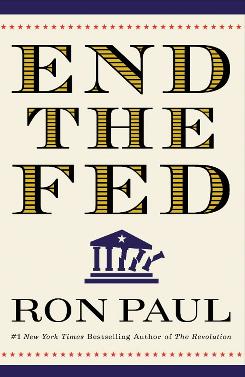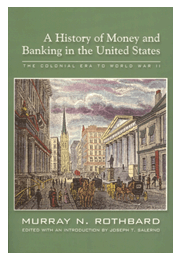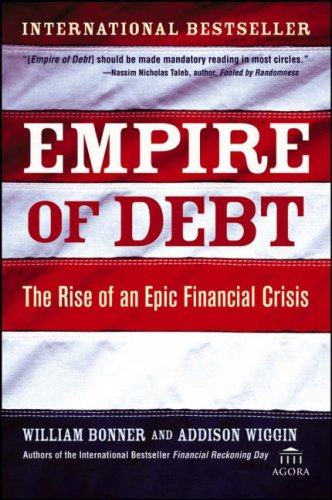
End The Fed
By Ron Paul
Grand Central Publishing 2009
210 pages. $21.99
The Federal Reserve Bank – referred to simply as the Fed – has been the recipient of constant criticism ever since its inception in 1913. The Fed’s critics span the spectrum, from conspiracy/survivalist nuts to the AFL-CIO to congressmen and senators. Conspiriologist Matthew Josephson believed the Fed was controlled by the Warburg Bank of Amsterdam, as part of a ‘Dutch’ takeover of England and America.
Congressman Wright Patman crusaded against the Fed for years, to no avail. Senators Jack Metcalf and Byron Dorgan spearheaded efforts to audit the Fed. Again, to no avail. In 1996, the AFL-CIO Executive Council condemned the Fed for “an unjustified assault on the Bureau of Labor Statistics.” This would, stated the Council, result in false indexing of the CPI (consumer price index), which would ultimately deprive workers and retirees of their savings.
Once more, to no avail.
Enter Ron Paul, who wrote End The Fed. Paul starts off by coming right to the point in his opening sentence: “Everybody thinks about money and almost everybody wants more.” From there, he moves on to demonstrate that the Fed has “a monopoly on money.” According to Ron Paul, this means the Fed is “the instrument by which our money and credit are constantly manipulated for the benefit of a privileged class.”
Paul then recounts the history of the Fed – its origin and its goals. Theoretically, the Fed’s job is to eliminate business cycles, boom and bust cycles. In reality, the Fed not only causes but also intensifies boom and bust cycles by means of its intervention in currency markets. In short, the Fed’s goal is to create inflation, which means increase the supply of money and credit. It does this by issuing “phony money” that creates a false boom. And as Paul points out, this manufactured prosperity is “followed by an all-too-real bust.”
One of the most interesting sections of End The Fed is Ron Paul’s discussions with Alan Greenspan and Ben Bernanke. Both men believe that “government spending is a source of economic growth.” Paul calls this belief “a superstition of the old-line Keynesians.” In Paul’s opinion, this is nothing more than a modified Robin Hood rationale: you can rob from the poor and give to the rich.
In Chapter 8, Paul examines ‘Congress’s Interest in Monetary Policy.’ Essentially, it is an exposition on power and money. He quotes Rahm Emanuel, who said: “You never want a serious crisis to go to waste.” In effect, Paul is echoing Naomi Klein’s proposition, which she put forth in her book The Shock Doctrine: governments use crises to increase the size and scope of governmental power. Paul is quick to point out that he doesn’t hold with a conspiracy between Congress and the Fed. Rather, Paul believes it’s an issue of “bad ideology.” Paul believes the real threat is “authoritarianism, supporting statism on moral grounds for whatever reason.”
‘The Current Mess’ is the title of Chapter 9. And it’s a doozy of a chapter. In it, Paul talks about the root problem of the current financial crisis. He pooh poohs the prevalent explanations: the shortcomings of free-market capitalism, lack of banking regulations, a paucity of credit, and the slumping housing market. When assigning blame, Paul points his finger in a different direction. He says, “These are all merely symptoms of a deeper problem: the Fed and its role in sustaining an unsustainable paper money system.” To support his contention, Paul quotes Treasury secretary Timothy Geithner, who said, “Real interest rates were very low for a long period of time.” The culprit, according to Paul, was the Fed, which deliberately kept interest rates low.
Paul states the Fed’s policy merely reflects the real problem. “The problem isn’t with the choices made by central bankers. The problem is that they possess the power to make any choice at all.” Paul doesn’t pull any punches. He lands a right cross when he says, “Manipulating interest rates is an immoral act. It’s economically destructive.”
In Chapter 10, Paul asks the question, ‘Why end the Fed?’ He answers the question in the first sentence of the chapter. “The Federal Reserve should be abolished because it is immoral, unconstitutional, impractical, promotes bad economics, and undermines liberty. Its destructive nature makes it a tool of tyrannical government.”
Whoa! Talk about hitting the nail on the head.
In the closing chapters of his book, Paul makes his case, arguing from a number of viewpoints. He presents the philosophical case, the economic case and, finally, the libertarian case. In each instance, his argument is delightful and superb, if somewhat irascible. He concludes his presentation with a remarkable statement. “There is a much better alternative.”
The last chapter of the book – Chapter 15 – is called ‘The Way Out.’ By which Paul means the way out of the current mess. The way out, according to Paul, is “to unplug the machinery of the Fed.” Turn it off. Paul also thinks returning to a gold standard “would impose discipline.” Whether or not there is a return to a gold standard, does not affect Paul’s primary premise: the Fed must end, because, according to Ron Paul, the Fed is a counterfeiting operation.
Paul is, however, a realist. He recognizes that the current mentality cannot accept change. “Most people, especially those in Washington, still believe this system can be salvaged.” He adds, “The future looks bleak.”
Still, Ron Paul is hopeful. He hopes that “End the Fed will become a reality.”
End The Fed is an astonishing book. Mostly, because it is so honest. And for that reason alone, it deserves to be read. Yet the book has other merits. Its tone is agreeable, and it is presented in contemporary language that’s easily understood. And because it’s easily understood, it is powerful stuff.
![]() On the Read-O-Meter, which ranges from 1 star (not very good) to 5 stars (spectacular), End The Fed ends up with 5 stars. You don’t want to miss this one.
On the Read-O-Meter, which ranges from 1 star (not very good) to 5 stars (spectacular), End The Fed ends up with 5 stars. You don’t want to miss this one.


